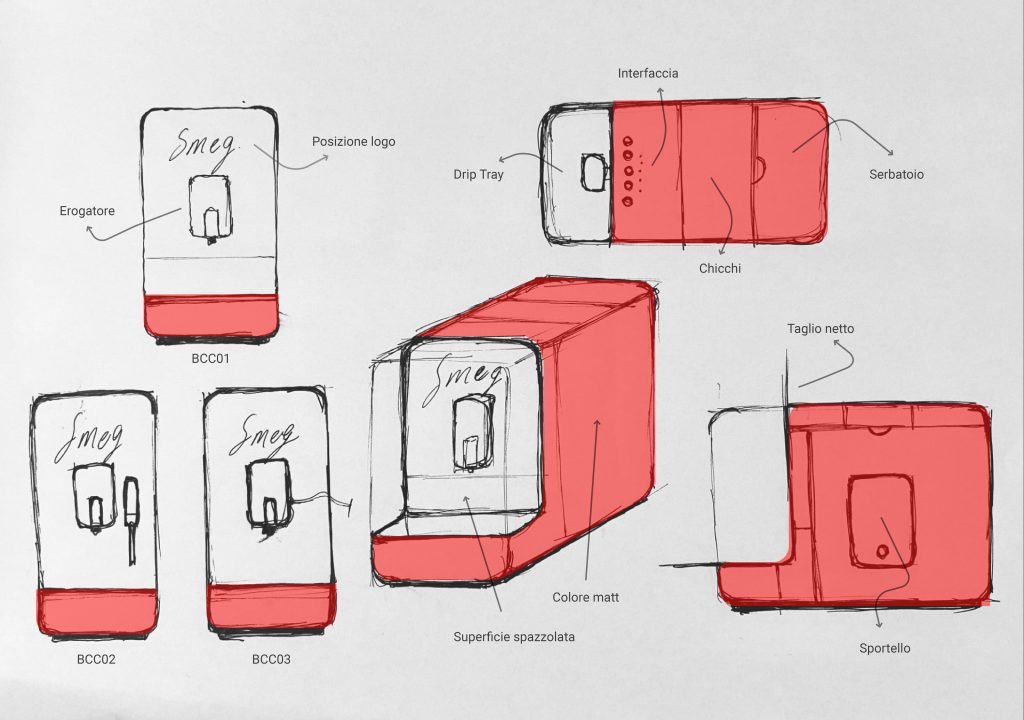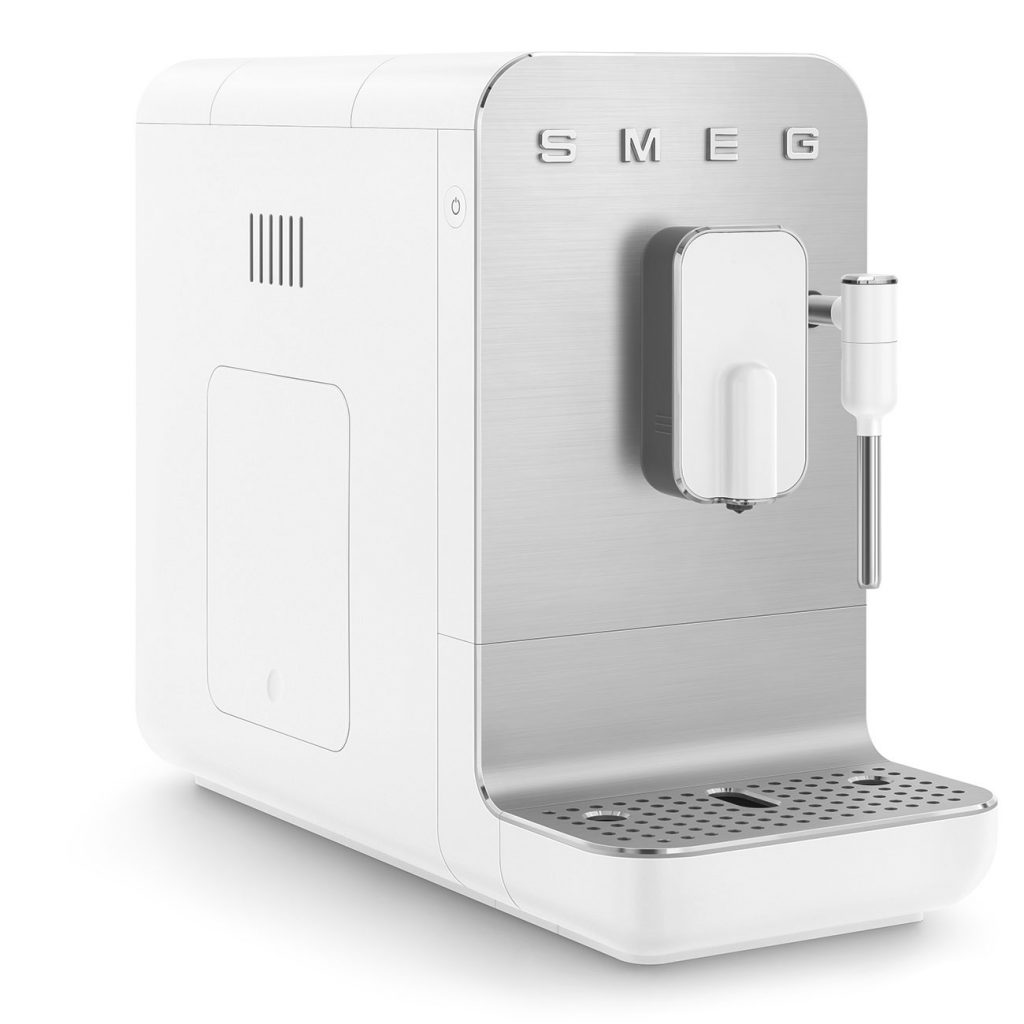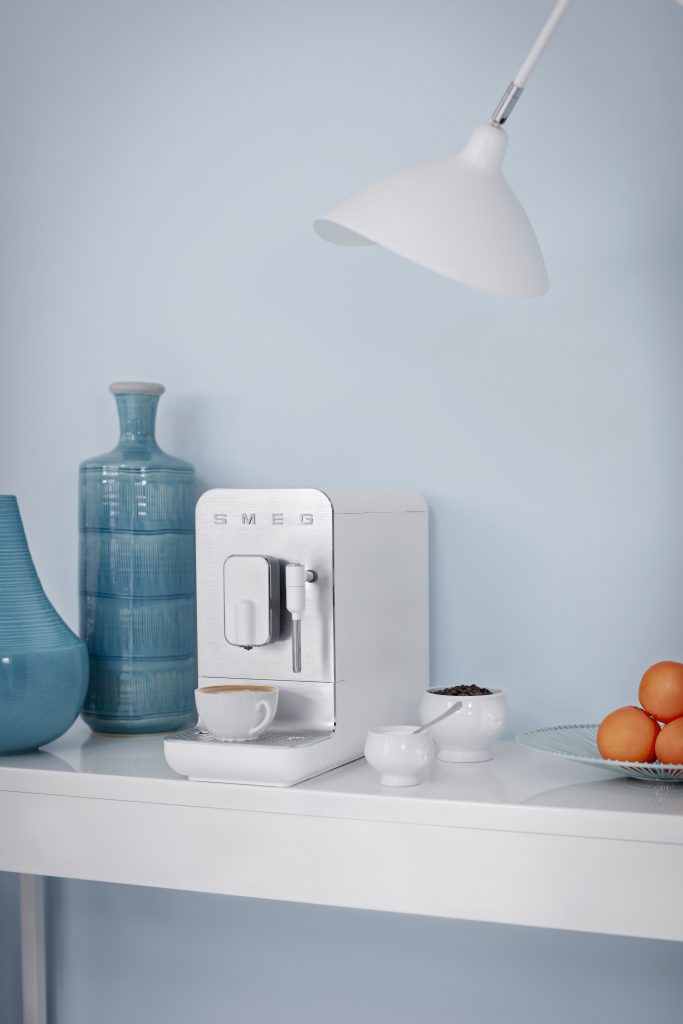A small light emerges from the nose of an espresso machine and illuminates the cup that fills to the sound of freshly ground beans. From the side, the glow is reflected in the curves drawn in the machine's aluminium. ‘This is how coffee stages its very show,’ says a voice. We are in Smeg's Milan store and the voice is that of Alumnus Matteo Bazzicalupo. He and Alumna Raffaella Mangiarotti, who is also here with us, designed this fully automatic espresso machine, the BCC Smeg, winner of the fourth edition of the DesignEuropa Award organised by the European Union Intellectual Property Office, in the Industry category. Their studio is called ‘deepdesign’ because - and we quote their words - ‘we work with research while questioning forms, in order to achieve a deep design’. So we decided to have a conversation precisely moving from the depths of thought that then lead to the creation of new lines.
'For twenty-five years we have been thinking about products not only from an aesthetic and functional point of view but also from a symbolic one,' explains Bazzicalupo. ‘The power of symbols goes beyond logical properties and reaches the heart and soul, allowing us to create an instantaneous and empathic relationship with those who interact with the product. The first image that came to our mind when thinking of this coffee machine was that of a monolithic geode. If you look at it, it has a very pure volume that resembles the device of a geode: it splits and holds a precious heart inside. Similarly, we have carved out a portion of the primary volume and a very valuable interior is unveiled: the underlying advanced technology platform that addresses the user. This metaphor tells a lot about the way we work and our reliance on a multi-factor methodology; on top of that, it also tells about the interaction that can be generated from the very beginning and that can then last over time'.
In a video presenting the espresso machine, Raffaela Mangiarotti wonders how to overcome the initial misunderstanding, that destructive stalemate in the relationship between machine and user. She wonders how to make objects talk. So we ask how objects can succeed in speaking to us. 'Form always expresses an iconic potential,' she says, 'and every object belongs to its own typological tradition that can be consecrated or desecrated. We feel free to choose how to act according to the business context we work in: sometimes we have consecrated and sometimes we have destroyed typologies because we considered that there might be different, more contemporary ways of seeing things. For example, we designed a washing machine and opted for centripetal instead of centrifugal force. We gave it a softer shape, its noise becomes a sound - more precisely the sound of water - and movements become fluid inside a machine that is no longer a white cube but is transparent. This is how functional things become emotional. In other cases, the typology itself is already perfect, as we realise it has come to us through so many hands and minds that have made it almost untouchable. In the case of this coffee machine, we have opted for very simple interfaces: we do not like to make it difficult for those who approach it. Of course, machines are getting smarter and smarter... but perhaps they don't need to show it, they should rather facilitate our decisions and ability to understand them. We thought of someone who wakes up in the morning, arrives in the kitchen almost with eyes still closed and simply wants to press a button to get a coffee. Among the four buttons, that person chooses one, smells the scent of coffee wafting through the air... we imagine that person almost always with their eyes closed: a real soft and powerful awakening at the same time. Then, if that person is an expert, if their eyes are already open, they discover that there is a mode whereby those four buttons control four other function options; or they can open the small machine door, turn a lever and choose the type of grind depending on the humidity of the day. It is a ‘level machine’, meaning that it is designed for various levels: from the simplest and most immediate to the deepest and most technical’.

So, going back to the moment of genesis, right after the lighting of the monolith, how did you proceed? Bazzicalupo replies: ‘Let's say that at the beginning of the job we were given the inside of the machine and we had to shape its skin. We therefore focused on its compactness as the most important thing: we had to imagine something not too oversized, something which could be placed under the kitchen wall unit. That’s when we realised that we could design a long, narrow shape. Working on the front became interesting at this point: we thought of a clean line, of a front with a very distinctive cut, as if it were the cut of a stone. The starting palette is composed of three colours but is expanding. At the moment the machine comes in white, black and taupe - the latter is a shade of colour reminiscent of café au lait. The front panel is made of natural aluminium and has a brushed finish with a polished edge, a stroke of light that outlines and emphasises the area of the cut’.
Mangiarotti adds: ‘We often study sound as well, as we want to try to turn noises into sounds. In this case, the sound of the coffee grinder conveys the idea that fresh coffee is being prepared. The noise of a grinder is probably not very romantic, but when you open the top door and the aroma is released, you fly with imagination to a coffee roastery. Sometimes, I fill the machine up and leave it open: it is as if the smell wakes me up too. In short, it is a coffee machine but also an olfactory machine'.
Mangiarotti adds: ‘We often study sound as well, as we want to try to turn noises into sounds. In this case, the sound of the coffee grinder conveys the idea that fresh coffee is being prepared. The noise of a grinder is probably not very romantic, but when you open the top door and the aroma is released, you fly with imagination to a coffee roastery. Sometimes, I fill the machine up and leave it open: it is as if the smell wakes me up too. In short, it is a coffee machine but also an olfactory machine'. How can a line drawn on a certain day, in a certain year, rise to eternal life? Mangiarotti thinks about it and responds: ‘Personally, I don't like formal solutions that are too extreme because I find that when you create a very strange object, you end up getting tired of it over time. I believe a line must embody calmness to be eternal. This way, it can be translated into the desire to create an object that, when you look at it, is both new and ever-present. Bazzicalupo adds: 'Yes, like an object that you feel you have introjected'. Mangiarotti then continues: ‘To design this coffee machine we took some time to think about what a line with this calmness could be. When you think of Smeg, you think of something that stands the test of time. Here we are surrounded by Guido Canali's 1960s designs, and if you work with a company that has objects that were beautiful and have remained beautiful, you feel a responsibility. We wanted to do something graceful, more playful, that spoke to young people but shared the same essential nature. We wanted an object that could recall memory while being immersed in the contemporary'.
Moving on to memories, Mangiarotti tells us what has remained of her time studying at Politecnico: ‘The scientific method. The first thing Marco Zanuso, my lecturer at Poli, taught me was the etymology of 'progettare’, the Italian verb meaning ‘to design': it comes from the Latin ‘proiectāre’, namely to throw forward. This shaped me. When we designed the centripetal force washing machine, the self-standing hair-dryer or the foldable electric broom, we made attempts to throw something forward, not to the side. In the case of another coffee machine, the Diamantina, we did archive research on the historic Diamante machine. Doing research is a form of respect: it assumes humility, it means going and learning about the intellect that came before you. Finally, you can also pay homage while also putting something of your own. Such scientific dimension to the project is the one I also see in the young people attending Politecnico today'. Bazzicalupo has one particular memory from his Politecnico days: ‘I remember the teaching we learnt from Francesco Trabucco on the day we had to decide on our thesis topic. A NASA engineer was present and suggested an ultralight gyrocopter - the ancestor of the helicopter. We were all excited... but we didn't even know what it was. I thus learnt that, in order to aspire to innovate and imagine the future, one must first of all accept without fear every new design challenge’.
After leaving Politecnico, how does a person start and how can one find themselves in a colleague? Mangiarotti and Bazzicalupo met in 1995 in the editorial office of the magazine ‘Modo’ founded by Alessandro Mendini, where they both wrote about innovation and technology, and so they decided to enter a competition together for the first time. Returning to the DesignEuropa Award, they tell us about the value of this first place: ‘Awards are usually related to the product’s aesthetics and functionality. In addition to these two aspects, which are the main ones, DesignEuropa considers a third parameter: the product’s commercial success. Not only the design but also the way the product was placed in a certain market segment - perhaps figuring out which element to remove or add to maintain a certain type of price - is part of the design. It’s thus about economic sustainability, because success corresponds to the revenue that pays back the professionalism and people behind the product itself. In our case, it’s also about environmental sustainability because this machine does not use capsules or pods and thus produces no waste: it goes from the bean directly to the cup'. They quote Good Design by Bruno Munari, in which the artist and designer plays with writing by describing an orange and peas as if they were design objects. ‘The ambition is always to follow a natural process,’ they say, ‘because there is no waste in nature. A leaf shows its lymphatic system, and you realise that it has nothing more than it needs... but you see it and it is wonderful. The result is an essential geometry that is turned into aesthetics. If we look around in this Smeg universe we are immersed in, we realise that there are another twenty iconic products designed by Mangiarotti and Bazzicalupo in addition to their automatic espresso machine. The two also designed this showroom and the one in London. We ask them how it feels to be here. ‘It feels a bit like home’.



